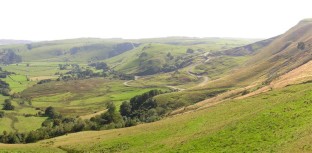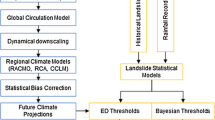Abstract
Global change is expected to result in worldwide increases in temperature and alteration of rainfall patterns. Such changes have the potential to modify stability of slopes, both natural and constructed. This paper discusses the potential effect of global climate change on reactivation of landslides through examination of predicted changes in rainfall pattern on the active landslide at Mam Tor, Derbyshire, UK. This landslide is of Pleistocene origin and is crossed by a road that is now abandoned. Damaging winter movement is known to occur when precipitation reaches both 1-month triggering and 6-month antecedent thresholds. Return periods for threshold exceedence is modelled statistically, and the climate change data from the UKCIP 2002 report (Hulme et al. 2002) is applied to this model. For the predicted changes in precipitation, it is shown that the instability threshold could decrease from 4 to 3.5 years by the 2080s for the medium–high climate change scenario. However, predicted temperature changes could influence the response of the landslide through increased evapotranspiration leading to a change in the triggering precipitation thresholds, and this will help counter the impact of changes in precipitation. Analysis of sources of uncertainty in the model has been used to establish the factors that contribute to the predicted changes in stability. Assessment of these factors can provide an indication of the potential impact of climate change on landslides in other areas of the UK.












Similar content being viewed by others
References
Buma J (2000) Finding the most suitable slope stability model for the assessment of the impact of climate change on a landslide in SE France. Earth Surf Proc Landf 25:565–583
Chowdhury R, Flentje P (2002) Uncertainties in rainfall-induced landslide hazard. Q J Eng Geol Hydrogeol 35:61–69
Collison A, Wade S, Griffiths J, Dehn M (2000) Modelling the impact of predicted climate change on landslide frequency and magnitude in SE England. Eng Geol 55:205–218
Corominas J, Moya J (1999) Reconstructing recent landslide activity in relation to rainfall in the Llobregat river basin, Eastern Pyrenees, Spain. Geomorphology 30:79–93
Dehn M, Burger G, Buma J, Gasparetto P (2000) Impact of climate change on slope stability using expanded downscaling. Eng Geol 55:193–204
Fiorillo F, Guadagno FM (2000) Analysis of rainfall triggering reactivations of a large landslide in Pleistocene Clay in Molise (Italy). In: Bromhead E, Dixon N, Ibsen M-L, Cardiff (eds) Proceedings of the 8th international symposium on landslides, pp 553–558
Hulme M, Jenkins GJ, Lu X, Turnpenny JR, Mitchell TD, Jones RG, Lowe J, Murphey JM, Hassell D, Boorman P, McDonald R, Hill S (2002) Climate change scenarios for the United Kingdom: the UKCIP02 scientific report. Centre for Climate Change Research, School of Environmental Sciences, University of East Anglia, Norwich
Mayes J (1996) Spatial and temporal fluctuations of monthly rainfall in the British Isles and variations in the mid-latitude westerly circulation. Int J Climatol 16:585–509
Rutter EH, Arkwright JC, Holloway RF, Waghorn D (2003) Strains and displacements in the Mam Tor landslip, Derbyshire, England. J Geol Soc 160:735–744
Shaw EM (1994) Hydrology in practice, 3rd edn. Chapman & Hall, London
Skempton AW, Leadbeater AD, Chandler RJ (1989) The Mam Tor landslide, Derbyshire. Philos Trans R Soc Lond A329:503–547
van Beek R (2002) Influence of environmental change on landslide activity. Netherlands Geological Studies 294, University Utrecht
Waltham AC, Dixon N (2000) Movement of the Mam Tor landslide, Derbyshire, UK. Q J Eng Geol Hydrogeol 33:105–123
Wilks DS (1995) Statistical methods in the atmospheric sciences: an introduction. Academic, San Diego
Acknowledgements
Thanks are due to Dr Tony Waltham, Dr Tom Dijkstra and Bob Elson for their helpful comments during the preparation of the manuscript.
Author information
Authors and Affiliations
Corresponding author
Rights and permissions
About this article
Cite this article
Dixon, N., Brook, E. Impact of predicted climate change on landslide reactivation: case study of Mam Tor, UK. Landslides 4, 137–147 (2007). https://doi.org/10.1007/s10346-006-0071-y
Received:
Accepted:
Published:
Issue Date:
DOI: https://doi.org/10.1007/s10346-006-0071-y




